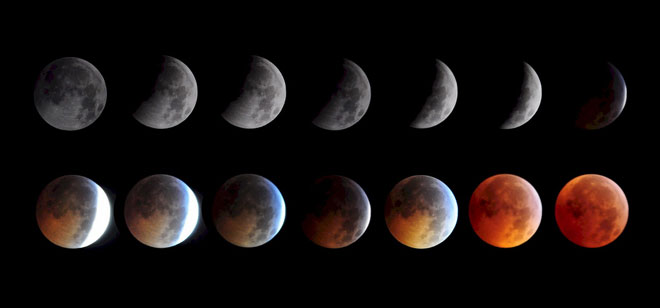Viewing Times and Tips for Saturday Morning’s Lunar Eclipse
Friday, December 9th, 2011
The last lunar eclipse until 2014 will grace the sky on Saturday, Dec. 10. Steve Edberg, an astronomer at NASA’s Jet Propulsion Laboratory, shares the best viewing times and tips. For more lunar eclipse resources and to join NASA/JPL’s “I’m There: Lunar Eclipse” event, visit http://1.usa.gov/uBfAI8.

Keith Burns submitted this winning photo of the December 2010 lunar eclipse as part of NASA/JPL’s “I’m There: Lunar Eclipse” Wallpaper contest. Planning to “be there” for the Dec. 10, 2011 eclipse? Post your images on the Total Lunar Eclipse Facebook event page for a chance to have your photo become an official NASA/JPL wallpaper. Copyright: Keith Burns
In the hours before dawn on Saturday morning, December 10, early risers in about half of the continental U.S. will have a chance to see at least some of a total lunar eclipse – the last one until 2014. The moon will be low in the western sky, and a clear, flat horizon without obscuring trees, buildings or mountains will make viewing easier. The setting of the moon and brightening of the sky as the sun rises will make observing the eclipse more challenging than usual, but more interesting too.
The moon’s passage has stages as it goes through the layers of Earth’s shadow. The outer ring of the shadow is called the penumbra. An observer on the moon would see a partial solar eclipse while the moon is in the penumbra. The core of Earth’s shadow is called the umbra. Observers on the moon would see a total eclipse of the sun when the moon is in the umbra. The time of moonset and the moon’s position in the earth’s shadow affects the view of the various stages of the event for observers across the US.
Washington, D.C. and the Eastern Time zone: The moon is setting just when it first enters the outer ring of Earth’s shadow. (This is called first penumbral contact, 06:33 EST, 05:33 CST, 04:33 MST, 03:33 PST, 01:33 AHST.) Effectively, no eclipse is visible. Sorry.
Chicago and the Central Time zone: Moonset is just before the moon enters the dark core of Earth’s shadow (called first umbral contact, 06:45 CST, 05:45 MST, 04:45 PST, 02:45 AHST). Observers in this region might see some darkening of a small section of the moon, just before the moon dips below the horizon.
Albuquerque and the Mountain Time zone: The moon sets (06:52 MST) with about 65 percent of its surface in the core of Earth’s shadow. Observers in this region will be able to see the moon’s entry and motion through Earth’s shadow until the moon disappears.
Los Angeles and the Pacific Time zone: With some variation from San Diego to Seattle, observers with an ocean horizon will be able to see the moon completely covered by the core of Earth’s shadow. (This is called totality, beginning at 06:06 PST, 04:06 AHST.) Southern observers will see a race between the end of totality and moonset. Observers in the Pacific Northwest will see the moon begin to emerge from the shadow core, ending totality (at 06:57 PST, 04:57 AHST). For them, the moon goes down (07:46 PST) in partial eclipse.
Honolulu and the Hawaiian Islands: Observers will see all phases involving the shadow core. Moonset occurs (07:05 AHST) after the last umbral contact, during the ending phase as the moon is exiting the outer ring of Earth’s shadow.
Anchorage, Alaska and northwestern Canada: The complete eclipse — from shadow outer ring entry, the moon’s passage through the shadow core, and its exit from the outer ring — will be visible before sunrise. The long nights at these latitudes make this possible.
The last total lunar eclipse visible in the US was about a year ago. Some of us will see a partial lunar eclipse next June, but after that we all wait until April 14-15, 2014 to see the whole spectacle of the moon passing through Earth’s shadow.





















